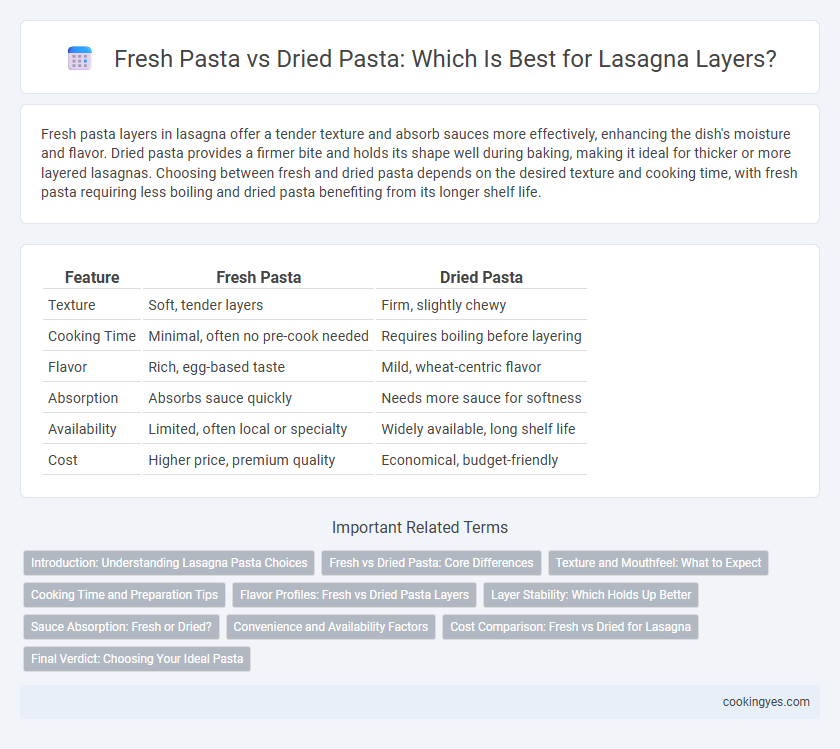Fresh pasta layers in lasagna offer a tender texture and absorb sauces more effectively, enhancing the dish's moisture and flavor. Dried pasta provides a firmer bite and holds its shape well during baking, making it ideal for thicker or more layered lasagnas. Choosing between fresh and dried pasta depends on the desired texture and cooking time, with fresh pasta requiring less boiling and dried pasta benefiting from its longer shelf life.
Table of Comparison
| Feature | Fresh Pasta | Dried Pasta |
|---|---|---|
| Texture | Soft, tender layers | Firm, slightly chewy |
| Cooking Time | Minimal, often no pre-cook needed | Requires boiling before layering |
| Flavor | Rich, egg-based taste | Mild, wheat-centric flavor |
| Absorption | Absorbs sauce quickly | Needs more sauce for softness |
| Availability | Limited, often local or specialty | Widely available, long shelf life |
| Cost | Higher price, premium quality | Economical, budget-friendly |
Introduction: Understanding Lasagna Pasta Choices
Fresh pasta offers a delicate texture and cooks faster, enhancing the rich, creamy layers in traditional lasagna recipes. Dried pasta provides a firmer bite and longer shelf life, allowing for robust layers that hold up well during baking. Selecting between fresh and dried pasta depends on desired texture, cooking time, and recipe authenticity.
Fresh vs Dried Pasta: Core Differences
Fresh pasta for lasagna offers a tender texture and cooks quickly, absorbing sauces better due to its higher moisture content. Dried pasta provides a firmer bite and longer shelf life, requiring boiling before layering to achieve optimal texture. The choice between fresh and dried pasta impacts the dish's overall creaminess and structure, dictating preparation methods and flavor absorption.
Texture and Mouthfeel: What to Expect
Fresh pasta used in lasagna layers offers a tender, delicate texture that absorbs sauce evenly, resulting in a creamy, melt-in-the-mouth mouthfeel. Dried pasta provides a firmer, chewier bite that holds its shape well during baking, creating distinct layers with more structural integrity. Choosing fresh or dried pasta affects the overall lasagna experience by balancing softness against a satisfying, al dente chew.
Cooking Time and Preparation Tips
Fresh pasta layers for lasagna typically cook faster, often needing only 2 to 4 minutes of boiling or a shorter baking time since they are tender and moist. In contrast, dried pasta requires longer soaking or pre-cooking, usually about 8 to 12 minutes, to soften properly before layering. To optimize texture, fresh pasta should be handled gently to prevent tearing, while dried pasta benefits from slightly undercooking to avoid mushy layers during baking.
Flavor Profiles: Fresh vs Dried Pasta Layers
Fresh pasta layers in lasagna offer a tender texture and delicate flavor that absorb sauces deeply, enhancing the overall richness of the dish. Dried pasta provides a firmer bite with a slightly nutty taste, which holds its shape well during baking and delivers a more pronounced wheat flavor. Choosing between fresh and dried pasta layers impacts the lasagna's mouthfeel and flavor intensity, tailoring the dish to personal preference or regional tradition.
Layer Stability: Which Holds Up Better
Fresh pasta offers superior layer stability for lasagna due to its pliability and moisture content, which allows it to better absorb sauces without becoming mushy. Dried pasta, while firmer and less prone to overcooking, can be more brittle and may not meld as seamlessly into the layered structure, risking separation during baking. Choosing fresh pasta enhances layer cohesion, resulting in a more stable, uniform lasagna with evenly distributed textures.
Sauce Absorption: Fresh or Dried?
Fresh pasta sheets for lasagna offer superior sauce absorption due to their porous texture and higher moisture content, allowing the sauce to penetrate and meld with the layers more effectively. Dried pasta, though firmer and denser, absorbs less sauce and tends to create distinct, separate layers rather than a cohesive, saucy bite. Selecting fresh pasta enhances the overall flavor harmony and moisture balance in traditional lasagna recipes.
Convenience and Availability Factors
Fresh pasta offers a tender texture that enhances lasagna layers but requires immediate use and refrigeration, limiting convenience for busy cooks. Dried pasta, widely available and shelf-stable, provides an accessible and time-saving option without sacrificing structural integrity during baking. Availability in most supermarkets and longer storage life make dried pasta the preferred choice for everyday lasagna preparation.
Cost Comparison: Fresh vs Dried for Lasagna
Fresh pasta for lasagna layers typically costs more due to higher ingredient quality and shorter shelf life, averaging around $5 to $7 per pound compared to dried pasta, which ranges between $1 to $3 per pound. The price difference reflects production methods, with fresh pasta requiring refrigeration and faster consumption, while dried pasta benefits from longer storage and mass production economies. Choosing dried pasta can significantly reduce overall lasagna preparation costs without sacrificing texture when properly cooked.
Final Verdict: Choosing Your Ideal Pasta
Fresh pasta offers a tender texture and cooks faster, enhancing the rich, creamy layers of lasagna with a delicate bite. Dried pasta provides sturdiness and better absorption of sauces, making it ideal for achieving distinct, well-structured layers that hold up during baking. Selecting between fresh and dried pasta ultimately depends on desired texture and cooking convenience, with fresh pasta favored for softer, more delicate lasagna and dried pasta preferred for firmer, more robust layering.
Fresh Pasta vs Dried Pasta for Lasagna Layers Infographic

 cookingyes.com
cookingyes.com